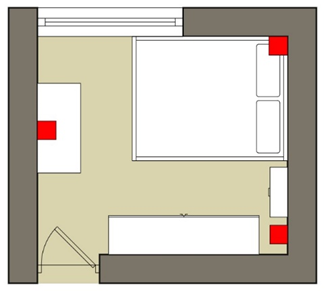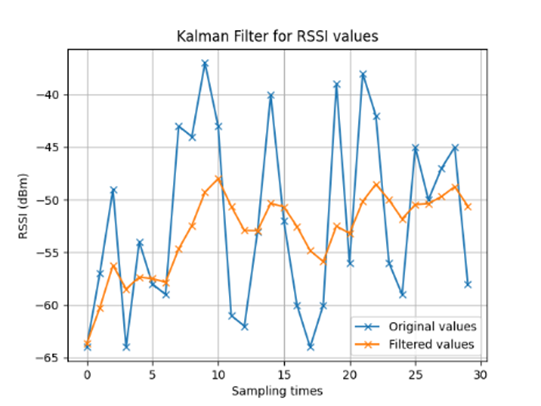This project implements an indoor positioning system (IPS) using Bluetooth Low Energy (BLE) technology. It utilizes RSSI (Received Signal Strength Indicator) values from three ESP32-S3 Feather modules acting as beacons to calculate the position of a target device through trilateration. The system processes these signals to provide real-time positioning within an indoor environment.
Figure: Layout of the experiment area
- Bluetooth RSSI Collection: Collects RSSI data from multiple ESP32-S3 Feather modules using MQTT.
- Kalman Filtering: Applies Kalman filtering to the RSSI data to enhance accuracy.
Figure: Line graph showing how the Kalman filter works
- Trilateration Algorithm: Employs trilateration to compute the position based on RSSI values.
- Real-time Visualization: Uses Matplotlib to display the positioning and RSSI data dynamically.
Figure: Graphical display run when the server is run, showing the trilateration and RSSI values received
- MQTT Communication: Leverages MQTT for efficient data transmission between the beacons and the central server.
- 3 x ESP32-S3 Feather Boards
- 1 x PC or Laptop
- 1 x Pixel Display
Figure: Example of what the pixel display will look like when the server is run
- 1 x BLE-capable Device (e.g., Headphones)
- Set up the MQTT Broker: Install and configure Mosquitto on your server. You can use the Docker Compose file provided in the
/mosquittodirectory. - Configure the ESP32-S3 Boards: Flash the ESP32-S3 boards with MicroPython and set them up to transmit RSSI data via MQTT. The necessary code for this can be found in the
/beaconsdirectory. - Run the Server: Start the server application on your PC to receive data and perform calculations. First, create a virtual environment (venv) and install the requirements.txt. Then, run the Python file located at
src/server.py.
Start the system by powering up the ESP32-S3 boards and the target BLE device. Ensure the MQTT broker is running, and execute the server script to begin receiving and processing data. The real-time location of the target device will be displayed on the pixel display and the Matplotlib graph.
Figure: Sequence diagram/flow of the solution
- Integration of additional beacons to improve coverage and accuracy.
- Exploration of alternative technologies such as Zigbee and Wi-Fi.
- Advanced filtering techniques to further refine signal processing.
Parts of this project make use of the python3-idotmatrix-client library for communicating with the pixel display.



